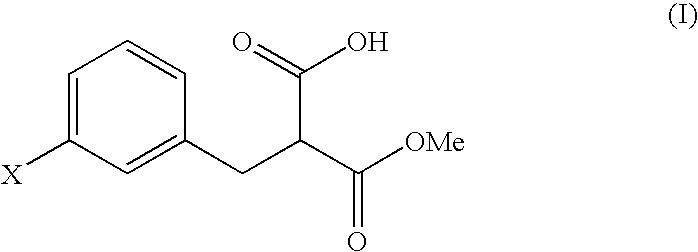Malonic acid monomethyl derivatives and production process thereof
a monomethyl and malonate technology, applied in the preparation of carboxylic acid esters, chemistry apparatus and processes, organic chemistry, etc., can solve the problems of difficult handling, unsuitable commercial production, difficult to manufacture, etc., and achieve the effect of easy and convenient production of monomethyl
- Summary
- Abstract
- Description
- Claims
- Application Information
AI Technical Summary
Benefits of technology
Problems solved by technology
Method used
Image
Examples
example 1
Preparation of 3-(3-chlorophenyl)-2-methoxycarbonylpropionic acid
[Step A: Preparation of dimethyl 3-chlorobenzylmalonate]
[0052]Aliquots of 6.6 g of m-chlorobenzyl chloride and 27.6 g of dimethyl malonate were dissolved in 41.8 g of dimethylacetamide, followed by mixing with 2.5 g of sodium hydroxide. The mixture was stirred at room temperature for 6 hours, was cooled to 5° C. or below, and was adjusted to pH 3.5 with 1.7 percent by weight hydrochloric acid. After adding 36.0 g of water, the product was extracted with 37.0 g of toluene, and the toluene layer was washed with two portions of 36.0 g of water. Toluene and unreacted dimethyl malonate were removed under reduced pressure, to yield 9.7 g of a concentrated residue. A total of 96 percent by weight of the residue was dimethyl 3-chlorobenzylmalonate (yield: 9.3 g, 95%).
[0053][Step B: Preparation of 3-(3-chlorophenyl)-2-methoxycarbonylpropionic acid]
[0054]A total of 9.5 g of the residue containing dimethyl 3-chlorobenzylmalonate ...
referential example 1
Preparation of methyl 2-chloroformyl-3-(3-chlorophenyl)-propionate
[0057]A total of 8.0 g of the residue containing 3-(3-chlorophenyl)-2-methoxycarbonylpropionic acid prepared in Step B of Example 1 was dissolved in 32.8 g of 1,2-dichloroethane under nitrogen atmosphere, and 11.8 g of thionyl chloride and 0.05 g of dimethylformamide were added thereto, followed by stirring at 40° C. for 7 hours. The resulting mixture was concentrated under reduced pressure to remove 1,2-dichloroethane and unreacted thionyl chloride to thereby yield 7.98 g of methyl 2-chloroformyl-3-(3-chlorophenyl)-propionate.
[Spectral data of methyl 2-chloroformyl-3-(3-chlorophenyl)-propionate]
[0058]1H-NMR (CDCl3) ppm: 3.27 (d, 2H, ClC6H4—CH2—CH), 3.78 (s, 3H, —COOCH3), 4.07 (t, 1H, ClC6H4—CH2—CH), 7.07–7.26 (m, 4H, ClC6H4—)
referential example 2
Preparation of methyl 5-chloro-1-oxo-2,3-dihydroindene-2-carboxylate(=5-chloro-2-methoxycarbonylindan-1-one)
[0059]Under nitrogen atmosphere, 9.0 g of anhydrous aluminum chloride and 151.3 g of 1, 2-dichloroethane were stirred to yield a suspension, and the suspension was cooled to 0° C. A mixture of 7.98 g of methyl 2-chloroformyl-3-(3-chlorophenyl)-propionate prepared in Referential Example 1 and 151.3 g of 1,2-dichloroethane was added dropwise to the suspension while maintaining the temperature at 5° C. or below, followed by stirring under the same condition for 2 hours. The reaction mixture was added dropwise to 53.6 g of 1.7 percent by weight hydrochloric acid cooled to 5° C. or below, followed by stirring under the same condition for 1 hour. After separating the mixture into a 1,2-dichloroethane layer and an aqueous layer, the product in the aqueous layer was extracted with 15.1 g of 1,2-dichloroethane. This procedure was repeated a total of two times. The resulting 1,2-dichlor...
PUM
| Property | Measurement | Unit |
|---|---|---|
| temperature | aaaaa | aaaaa |
| temperature | aaaaa | aaaaa |
| melting point | aaaaa | aaaaa |
Abstract
Description
Claims
Application Information
 Login to View More
Login to View More - R&D
- Intellectual Property
- Life Sciences
- Materials
- Tech Scout
- Unparalleled Data Quality
- Higher Quality Content
- 60% Fewer Hallucinations
Browse by: Latest US Patents, China's latest patents, Technical Efficacy Thesaurus, Application Domain, Technology Topic, Popular Technical Reports.
© 2025 PatSnap. All rights reserved.Legal|Privacy policy|Modern Slavery Act Transparency Statement|Sitemap|About US| Contact US: help@patsnap.com



